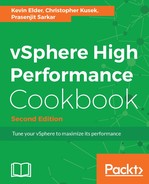There are three levels of data protection available for pools, using nothing but RAID levels; these three levels are as follows:
- RAID 5 has good data protection capability and has excellent read performance. However, it does not have much write performance and that is due to parity calculations. As it uses parity, if one drive of a private RAID group fails, no data is lost. RAID 5 is appropriate for small- to medium-sized pools. If capacity utilization or performance is a priority and we have a solid design for data protection in place (backups, replication, hot spares, and so on), then having RAID level 5 is a sound decision:

- RAID 6 provides the highest data availability. It is similar to RAID 5; however, it uses striping with parity and uses two parity drives. With the second parity drive, up to two drives may fail in a private RAID group and result in no data loss. RAID 6 is appropriate for any size pool, including the largest possible. The downside is that you get less usable space than RAID 5. If the priority is absolutely on availability, then RAID 6 is recommended at the cost of performance. It is generally used for larger, slower disk drives:

- RAID 1/0 or RAID 10 has high data availability. In this RAID, two drives are mirrored together and then striped. Because of this design, you can achieve high I/O rates (especially small random write I/Os). A single disk failure in a private RAID group results in no data loss. However, if a primary and its mirror fail together, then data will be lost. RAID 10 is inefficient as half the available space is taken by copies of the data. If you need faster storage performance, RAID 10 is a simple, relatively cheaper fix:

